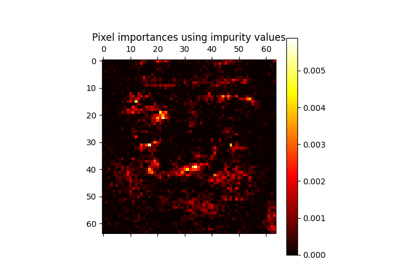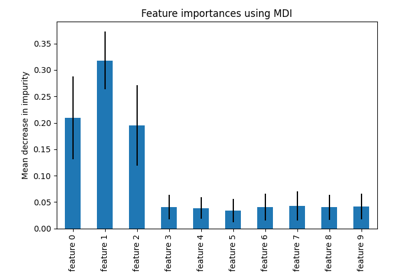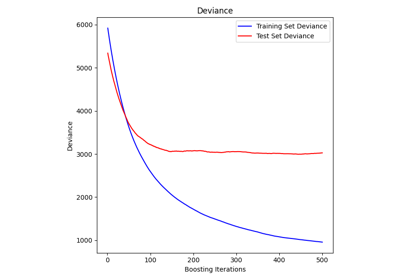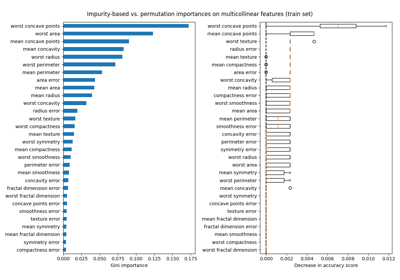permutation_importance#
- sklearn.inspection.permutation_importance(estimator, X, y, *, scoring=None, n_repeats=5, n_jobs=None, random_state=None, sample_weight=None, max_samples=1.0)#
排列重要性用于特征评估 [BRE].
estimator 需要是一个已经 fitted 的估计器。
X可以是用于训练估计器的数据集或是一个保留集。特征的排列重要性计算如下。首先,在由X定义的(可能是不同的)数据集上评估一个基准指标,该指标由 scoring 定义。接下来,从验证集中随机排列一个特征列,并再次评估该指标。排列重要性定义为基准指标与排列特征列后的指标之间的差异。更多信息请参阅 用户指南 。
- Parameters:
- estimatorobject
一个已经 fitted 并且与 scorer 兼容的估计器。
- Xndarray 或 DataFrame, shape (n_samples, n_features)
将在其上计算排列重要性的数据。
- yarray-like 或 None, shape (n_samples, ) 或 (n_samples, n_classes)
监督学习的目标或无监督学习的
None。- scoringstr, callable, list, tuple, 或 dict, default=None
使用的评分器。 如果
scoring表示单个分数,可以使用:单个字符串(见 scoring_parameter );
返回单个值的可调用对象(见 从指标函数定义您的评分策略 )。
如果
scoring表示多个分数,可以使用:唯一字符串的列表或元组;
返回字典的可调用对象,其中键是指标名称,值是指标分数;
以指标名称为键、可调用对象为值的字典。
向
scoring传递多个分数比为每个分数调用permutation_importance更高效,因为它重用了预测结果以避免重复计算。如果为 None,则使用估计器的默认评分器。
- n_repeatsint, default=5
每个特征的排列次数。
- n_jobsint 或 None, default=None
并行运行的作业数。计算是通过为每个列计算排列分数并在列上并行化完成的。
None表示 1,除非在joblib.parallel_backend上下文中。-1表示使用所有处理器。详见 Glossary 。- random_stateint, RandomState 实例, default=None
伪随机数生成器,用于控制每个特征的排列。 传递一个 int 以在函数调用之间获得可重复的结果。 详见 Glossary 。
- sample_weightarray-like of shape (n_samples,), default=None
评分中使用的样本权重。
Added in version 0.24.
- max_samplesint 或 float, default=1.0
每次重复中从
X抽取的样本数(不重复)。如果是 int,则抽取
max_samples个样本。如果是 float,则抽取
max_samples * X.shape[0]个样本。如果
max_samples等于1.0或X.shape[0],则使用所有样本。
虽然使用此选项可能提供不太准确的特征重要性估计,但它使该方法在评估大型数据集上的特征重要性时保持可行。与
n_repeats结合使用,这允许控制该方法的计算速度与统计准确性之间的权衡。Added in version 1.0.
- Returns:
- result
Bunch或此类实例的字典 类似字典的对象,具有以下属性。
- importances_meanndarray of shape (n_features, )
n_repeats上特征重要性的均值。- importances_stdndarray of shape (n_features, )
n_repeats上特征重要性的标准差。- importancesndarray of shape (n_features, n_repeats)
原始排列重要性分数。
如果 scoring 参数中有多个评分指标,
result是一个以评分器名称为键(例如 ‘roc_auc’)、上述Bunch对象为值的字典。
- result
References
Examples
>>> from sklearn.linear_model import LogisticRegression >>> from sklearn.inspection import permutation_importance >>> X = [[1, 9, 9],[1, 9, 9],[1, 9, 9], ... [0, 9, 9],[0, 9, 9],[0, 9, 9]] >>> y = [1, 1, 1, 0, 0, 0] >>> clf = LogisticRegression().fit(X, y) >>> result = permutation_importance(clf, X, y, n_repeats=10, ... random_state=0) >>> result.importances_mean array([0.4666..., 0. , 0. ]) >>> result.importances_std array([0.2211..., 0. , 0. ])







